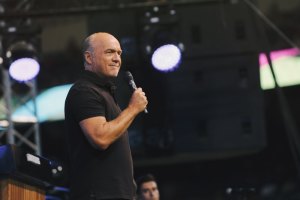Man Moves Paralyzed Hand With Thoughts Thanks to Mind Reading Chip Implanted in Brain; Hope for Stroke, Brain Injury Victims

In a scientific breakthrough seen as a ray of hope for stroke and brain injury victims, a paralyzed man was able to use his thoughts to move his hand and fingers through the use of a device called Neurobridge, which was developed in a partnership between The Ohio State University Wexner Medical Center and Battelle.
Neurobridge, according to a release from OSU, is "an electronic neural bypass for spinal cord injuries that reconnects the brain directly to muscles, allowing voluntary and functional control of a paralyzed limb."
Ian Burkhart, 23, a quadriplegic from Dublin, Ohio, was the first of a possible five participants to test the technology in a clinical student.
"It's much like a heart bypass, but instead of bypassing blood, we're actually bypassing electrical signals," explained Chad Bouton, research leader at Battelle. "We're taking those signals from the brain, going around the injury, and actually going directly to the muscles."
The technology, which was in development for nearly a decade, combines algorithms that learn and decode the user's brain activity and a high-definition muscle stimulation sleeve that translates neural impulses from the brain and transmits new signals to the paralyzed limb, according to the release.
And Burkhart, who was paralyzed four years ago during a diving accident, explained that his decision to be a part of the trial was influenced by his love for science and the opportunity to help people like himself.
"Initially, it piqued my interested because I like science, and it's pretty interesting," he said in the release. "I've realized, 'You know what? This is the way it is. You're going to have to make the best out of it.' You can sit and complain about it, but that's not going to help you at all. So, you might as well work hard, do what you can and keep going on with life."
Bouton and his team began collaborating with Ohio State neuroscience researchers and clinicians Dr. Ali Rezai and Dr. Jerry Mysiw to design the clinical trials and validate the feasibility of using the Neurobridge technology in patients two years ago, explains the OSU release.
On April 22, Rezai implanted a chip smaller than a pea onto the motor cortex of Burkhart's brain in a three-hour surgery.
"The chip interprets brain signals and sends them to a computer, which recodes and sends them to the high-definition electrode stimulation sleeve that stimulates the proper muscles to execute his desired movements. Within a tenth of a second, Burkhart's thoughts are translated into action," noted the release.
"The surgery required the precise implantation of the micro-chip sensor in the area of Ian's brain that controls his arm and hand movements," said Rezai, who is hoping that Neurobridge will one day be used to help patients with brain and spinal cord injuries.
"I've been doing rehabilitation for a lot of years, and this is a tremendous stride forward in what we can offer these people," said Mysiw, chair of the Department of Physical Medicine and Rehabilitation at Ohio State. "Now we're examining human-machine interfaces and interactions, and how that type of technology can help."




























